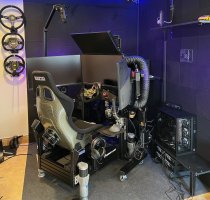Good catch. We used and tested transducers for a some time before implementing EV. To me it was always lackluster, not enough punch, specially if not mounted properly. But they are cost effective and have two other notable advantages:
1) Transducers can be localized or mounted in specific locations.
2) They represent the higher frequencies well or up to 200Hz. Which is where most motion systems struggle. After 200Hz - 300Hz the transducers become speakers.
That is a good question and it really does come to tunning and preference. I personally like just the DK2 system and its more than enough to represent the haptics. I don't think the two systems will clash if they are setup properly as OlaGB outlined above. Personally though I like the simple DK2 only solution. :-P
1) Transducers can be localized or mounted in specific locations.
2) They represent the higher frequencies well or up to 200Hz. Which is where most motion systems struggle. After 200Hz - 300Hz the transducers become speakers.
That is a good question and it really does come to tunning and preference. I personally like just the DK2 system and its more than enough to represent the haptics. I don't think the two systems will clash if they are setup properly as OlaGB outlined above. Personally though I like the simple DK2 only solution. :-P












